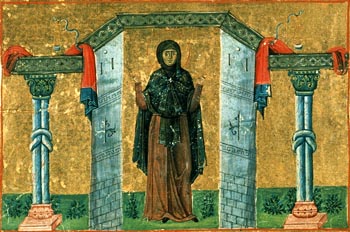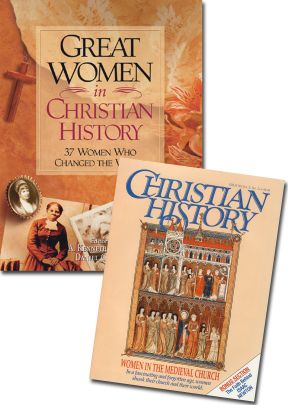MELANIA: HOW THE RICHEST WOMAN IN THE WORLD LIVED

[Melania the Younger, from the Menologion of Basil II Public Domain / Wikipedia 2]
IMAGINE YOURSELF the richest woman in the world, owner of numerous estates, mansions, and slaves on three continents. Then imagine giving up every penny of it for Christ’s sake. Melania the Younger (born c. 383) did just that.
Reared a Christian, Melania loathed the decadence of Rome even as a child and wanted to follow an ascetic and celibate life, believing it was the path to perfection. Her wealthy parents insisted, however, that she marry. The man they chose, Pinianus, was a cousin on her father’s side, also heir to immense wealth and a nominal Christian. They married shortly before Melania's fourteenth birthday. Pinianus was just three years older. Their marriage brought together the two richest estates in the Roman Empire with holdings in Italy, Sicily, Gallia, Spain, Britain, Carthage, Numidia, Mauritania, Mesopotamia, Syria, Palestine, and Egypt. Included were thousands of slaves.
Although married, Melania desired celibacy, and in keeping with Christ’s command to the rich young ruler, she also wanted to give away all she owned. Pinianus insisted they first have at least two children. A daughter and son were born to them. The son died the day of his birth. The daughter followed not long afterward. Pinianus recognized the hand of God in his thwarted plans and agreed he and Melania should relinquish their wealth and live celibate. They began selling their property, giving the money to charity and to religious foundations. Their holdings were so vast, this work took decades. In Italy alone, they freed 8,000 slaves. One of their mansions was so expensive no buyer could be found for it.
In 408 the still-wealthy couple left Rome because of the advance of the Visigoths, settling in Sicily. In 410 they moved to North Africa with Melania’s mother and divested their African holdings. There Melania met Augustine of Hippo and his friend Alypius, both bishops. Melania founded a nunnery and a men’s monastery. She also gave freely wherever there was need.
In 417, Melania, her mother, and Pinianus went to Jerusalem by way of Egypt. In Alexandria they met Cyril, the opponent of Bishop Nestorius whose views on Christ were suspect. (Later, after establishing residence in Jerusalem, Melania would return to Egypt to visit the desert fathers.)
In Jerusalem Melania became acquainted with famed Bible scholar Jerome. She founded a monastery for ninety virgins on the Mount of Olives although she refused to head the institution. Shortly after settling in Jerusalem, Melania and Pinianus distributed the last of their vast wealth. This was from Spanish estates whose sale had been delayed because of war. They now lived in poverty, dependent on others. Melania secluded herself as much as she could for prayer and fasting, seldom seeing her husband, who died before her (c. 420). She considered the first part of her life the Martha years (years of service) and the remainder the Mary years (years of feasting on Christ’s teaching and presence).
She built a men’s monastery on the Mount of Ascension with money donated by others. Meanwhile she enshrined relics at the women’s monastery, including relics of the prophet Zechariah, Stephen the martyr, and the Forty Martyrs of Sebaste.
Concern for an unsaved uncle induced her to travel to Constantinople, where she led him to Christ on his death bed. She repudiated the views of the deposed bishop, Nestorius, and won some of his followers back to orthodoxy. Back in Jerusalem, she received a visit from Empress Eudocia in 438. That was the last significant event of her life. On this day 31 December 439, Melania the Younger died.
—Dan Graves
----- ----- ------
For more stories of notable Christian women, read Great Women in Christian History






